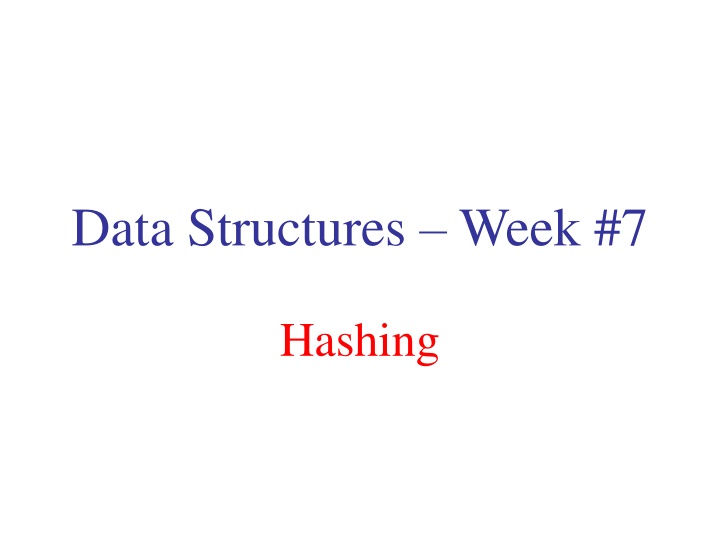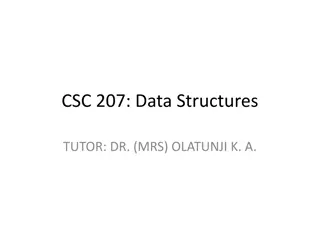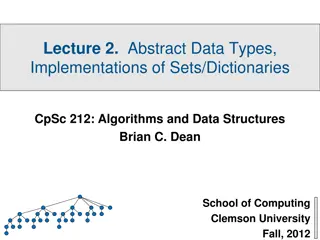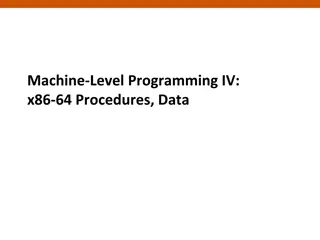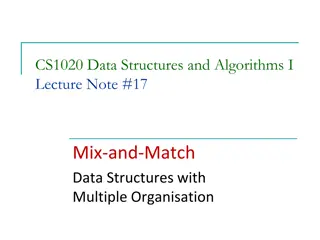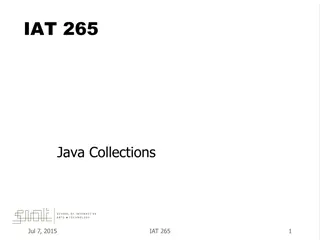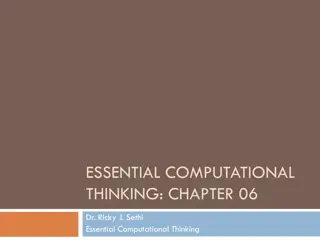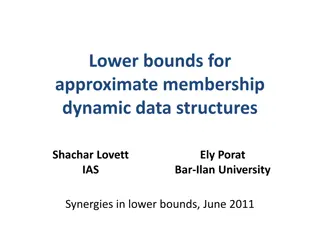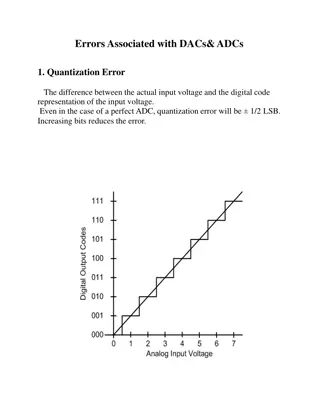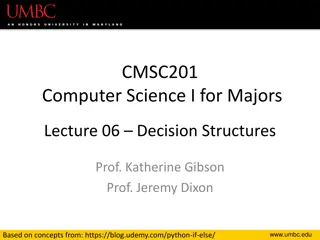Data Structures
This content delves into the concept of hashing in data structures, discussing its motivation, underlying idea, hash tables, hash functions, separate chaining, open addressing, rehashing, and performance comparisons with arrays. Hashing allows for efficient operations like search, insert, and remove in constant time, offering a solution to handling dynamic data sets effectively.
Download Presentation

Please find below an Image/Link to download the presentation.
The content on the website is provided AS IS for your information and personal use only. It may not be sold, licensed, or shared on other websites without obtaining consent from the author.If you encounter any issues during the download, it is possible that the publisher has removed the file from their server.
You are allowed to download the files provided on this website for personal or commercial use, subject to the condition that they are used lawfully. All files are the property of their respective owners.
The content on the website is provided AS IS for your information and personal use only. It may not be sold, licensed, or shared on other websites without obtaining consent from the author.
E N D
Presentation Transcript
Data Structures Week #7 Hashing
Outline Motivation for Hashing Underlying Idea Hash Tables Hash Functions Separate Chaining Open Addressing Rehashing April 12, 2025 Borahan T mer, Ph.D. 2
Hashing April 12, 2025 Borahan T mer, Ph.D. 3
Motivation for Hashing Keeping a data set of dynamic (i.e., rapidly changing) nature in an array is costly. Cost of operations such as search, insert and remove depends upon how data resides in the array (i.e., orderedor not) Unordered data in array take linear time to search and remove (and constant time to insert), while Ordered sequences make use of binary search and can be searched in O(log2n)time, although insertion and removal still take O(n), since a shift operation is required to follow these operations for the data to remain contiguous after these operations. The table on the following page summarizes the performance of operations for ordered and unordered data. April 12, 2025 Borahan T mer, Ph.D. 4
Motivation for Hashing Operation (in arrays) Unordered Data Ordered Data Insert O(1) O(n) Remove O(n) O(n) Search O(n) O(logn) April 12, 2025 Borahan T mer, Ph.D. 5
Motivation for Hashing Question: May we find a way to perform these operations in average constant time (O(1))? Hash tables or hashing is the answer to the above question. In the following pages, we will define what a hash table is. April 12, 2025 Borahan T mer, Ph.D. 6
Underlying Idea Consider a data set S={1, ,k}, k small (e.g. at most as large as a reasonable array size). You may place each number into the corresponding cell of an array of size k using a one-to-one mapping. In the figure, this is a linear mapping. This mapping from keys to the array index is called direct addressing. S 8 23 5 7 1 2 3 4 5 6 7 8 9 10 One-to-one function: f(key)=key April 12, 2025 Borahan T mer, Ph.D. 7
Underlying Idea To handle many real world case, it is reasonable to assume data is generated from an inexhaustible source. Hence we assume the infinity of data. Then, no array will be capable of holding the entire data. Solution is to use an array of some sufficient size m much less than the original data size k and to allow many-to-one mapping. This array is called a hash table and the many-to-one mapping is known as the hash function. (Check next figure!) April 12, 2025 Borahan T mer, Ph.D. 8
Hash Tables Hash Tables Here, the data size, K, is much greater than the size of the array, M or K >> M. Hence, several keys may get mapped to the same array cell according to the given many-to-one mapping mechanism. The mapping mechanism used is called the hash function. The attempt to hash a key to an occupied location of the hash table due to the many-to-one nature of the hash function is called a collision. Following the discussion regarding hash functions, we will discuss strategies about how to avoid and resolve collisions. A ak aK a3 a1a2 a5 a4 a6 U 1 2 3 m-1m m+1 ... M Many-to-one mapping function m=h(ak); m is the hash value; ak is the key. April 12, 2025 Borahan T mer, Ph.D. 9
Hash Functions A hash function should be easy to compute; distribute keys evenly within the hash table ensure equally likely hash values. The performance of hashing depends on the effectiveness of the hash function. April 12, 2025 Borahan T mer, Ph.D. 10
Making a Hash Function Typically, 1. the table size M is chosen to be a prime number that is the first larger one than the necessary size of the table if it is known (e.g., choose 11 if 10 is enough); 2. some natural way is selected to convert keys to large numbers r (i.e., ak r), and 3. modulo M of this large number (r mod M) is obtained as the hash value of the key. April 12, 2025 Borahan T mer, Ph.D. 11
Examples to Hash Functions Natural Ways to convert string keys to large numbers (i.e., ak r) Adding up ASCII values of characters in a string Example:ali 97+108+105=310 A good hash function? Another method: f(k)=key[0]+27*key[1]+729*key[2]; 263 combinations possible for the first three letters However, only around 2850 are meaningful. Horner s Rule April 12, 2025 Borahan T mer, Ph.D. 12
A Hash Function Adding up the ASCII values of the characters in the string. Any problems with that strategy? Assume we chose a big hash table size (considering that we will place strings or words in the structure, a large hash table is not unreasonable at all) such as 10000 (or 10007 if you want to make it prime). We usually use words composed at most of eight characters. This means that the first 1016 (why?) cells are most likely to be allocated. The rest of the hash table space will mostly remain empty. Hence, the data are not evenly distributed. April 12, 2025 Borahan T mer, Ph.D. 13
Another Hash Function Consider a hashing mechanism considering only the first three characters of a word and processing it as follows: key[0]+key[1]*27+key[2]*272 mod tablesize Here 27 is selected regarding the fact that the English alphabet has 26 letters. This is a good selection provided that the occurrence of the first three characters of English words are quite uniformly distributed over the set of all three-character strings. Unfortunately, this is not true. Out of a total of 263=17576 possible combinations, only 2851 three-character strings are meaningful, and hence, encountered in an online English dictionary. Hence, even if no collisions happen in a table chosen as above, 28% of the hash table would be full. For large tables this is not a good function to use. April 12, 2025 Borahan T mer, Ph.D. 14
Horners Rule Horner s rule: Another hash function proposed by Horner and called Horner s rule, has the formulation below: This mechanism is better than the two former functions. If the strings are too long, it takes long for hash values to compute. Then a certain substring of the key may be used. 1 keysize 0 * ] 1 imod [ 37 key keysize i tablesize = i April 12, 2025 Borahan T mer, Ph.D. 15
Hash Functions for Integer Keys Truncation Method: Take the first few or last few characters or digits as the hash code. This method is easy and fast. e.g., Consider Example2, only a subset of the id digits can be used. If 3 high-order digits are used then a table of size 1000 can be created. Collisions? Division Method: We map a key k into one of m slots by taking the remainder of k divided by m. Quite fast e.g., k=34752 |1000 (maxItems = 1000) 34 ______ 752 That is the hash function is h(k) = k mod m April 12, 2025 Borahan T mer, Ph.D. 16
More Examples to Hash Functions Multiplication Method: Operates in two steps. First, we multiply the key, k by a constant in the range 0<A<1 and extract the fractional part. Then, we multiply this value by m and take the floor of the result. That is the hash function is h(k) = m (kA mod 1) e.g., k=123456, m=10000, and A = ( 5-1)/2 h(k) = 10000 * (123456* 0.61803 mod 1 ) = 10000 * 0.0041151 = 41.151 = 41 April 12, 2025 Borahan T mer, Ph.D. 17
More Examples to Hash Functions Midsquare Method: The key is multiplied by itself (squared) and then the middle few digits of the result are selected as the hash code. e.g., k = 510324 h(510324) = 058 k2 = 260430584976 April 12, 2025 Borahan T mer, Ph.D. 18
More Examples to Hash Functions Key is partitioned or divided into several pieces. Pieces are operated upon in some way. Adding them together and taking the required number of digits as the hash code is one of the possibilities. e.g., k = 510324 Folding method 1: 51 03 24 78 For m=1000, h(k) = 078 Folding method 2: Fold left and right sections 1 03 2 5 4 15 03 42 60 April 12, 2025 Borahan T mer, Ph.D. 19
Separate Chaining April 12, 2025 Borahan T mer, Ph.D. 20
Open Addressing (Closed Hashing) The hash table has a fixed size, M. Any data point ak A under consideration is placed in the hash table. The hash table cell, m, the data point akis placed is determined by the hash function, h, or m=h(ak). Since K>>M, sometimes collisions occur. To resolve the collisions, we use collision resolution strategies. April 12, 2025 Borahan T mer, Ph.D. 21
Analysis of Open Addressing We will express the performance of hash tables in terms of the load factor a of the hash table. Load Factor: The rate of full cells over all cells of the hash table, or a=n/m, where n is the number of occupied table cells, and m is the table size. April 12, 2025 Borahan T mer, Ph.D. 22
Cost of Unsuccessful Search & Insert In an unsuccessful search, at the end of the search, we find out that the key is not in the hash table once we find an empty table cell. This is also what we do to insert a key into the hash table. We insert the key when we find an available space (unoccupied or empty table cell). Hence, for both operations, we will attempt to find the expected number of checks (probes) we make before we find an available table cell. April 12, 2025 Borahan T mer, Ph.D. 23
Cost of Unsuccessful Search & Insert Assume X is an RV and represents the number of probes made in an unsuccessful search. The probability that X is at least i (i.e., x i) probes before an empty slot is found is: 1 i + 1 2 2 n n n n i n = = 1 i ( ) p x i a + 1 2 2 m m m m i m April 12, 2025 Borahan T mer, Ph.D. 24
Cost of Unsuccessful Search & Insert The expected number of probes made in an unsuccessful search is at most: = = ( = = = + [ ] ( ) ( ) ( ) 1 E X ip X i i p X i p X i 1 1 i i = 2 + [ ] ( ) 1 ) 2 E X p X p X + ( ) 2 2 ( ) 3 p X p X + 3 ( ) 3 3 ( ) 4 p X p X ( + 4 ( ) 4 4 ) 5 p X p X 1 = = = = = = 1 i i [ ] ( ) E X p X i a a 1 a 1 1 0 i i i April 12, 2025 Borahan T mer, Ph.D. 25
Cost of Successful Search From the last slide we remember that the expected number of probes for the insertion of a key is at most 1/(1-a), a being the load factor. If, for instance, the key inserted is the (i+1)st key, then, the expected number of probes cannot exceed: 1 1 1 m = = 1 a m i i m April 12, 2025 Borahan T mer, Ph.D. 26
Cost of Successful Search Using this info, the expected number of probes for a successful search can be found by averaging m/(m-i) for the (i+1)st key over n keys as follows: 1 1 1 1 1 1 1 1 1 n = n = m m = = = + + + + ( ) t n + 1 2 1 n m i n m i a m m m m n 0 0 i i m 1 1 1 1 1 1 1 1 1 m m = n m dx m = 1 = = = = ( ) ln ln t n 1 a i i a i a x a m n a n = + 1 1 1 i i i m n m m n 1 = ( ) ln t n 1 a a April 12, 2025 Borahan T mer, Ph.D. 27
Resolving Collisions in Hash Tables Collision Resolving Strategies Linear Probing Quadratic Probing Double Hashing April 12, 2025 Borahan T mer, Ph.D. 28
Linear Probing Given an ordinary hash function h: A {0,1, , m-1}, the method of linear probing uses the hash function h (ak,i ) = (h(ak) + i ) mod m where i is the number of collisions occurred for the current key. April 12, 2025 Borahan T mer, Ph.D. 29
Linear Probing: Example i\keys Empty 24 116 50 66 26 259 144 247 40 51 0 50 50 50 50 50 50 50 50 1 66 66 66 66 66 66 66 2 26 26 26 26 26 26 3 259 259 259 259 259 4 144 144 144 144 5 247 247 247 6 40 40 7 51 8 9 10 11 24 24 24 24 24 24 24 24 24 24 12 116 116 116 116 116 116 116 116 116 CF 0 0 2 0 2 4 3 5 5 8 April 12, 2025 Borahan T mer, Ph.D. 30
Quadratic Probing Quadratic probing: uses a hash function of the form h (ak,i ) = (h(ak) + c1i + c2 i2 ) mod m where i is the number of collisions occurred for the current key, and cis are the coefficients of the quadratic function. April 12, 2025 Borahan T mer, Ph.D. 31
Quadratic Probing: Example i\keys Empty 24 116 50 66 26 259 144 247 40 51 0 26 26 26 26 26 26 1 66 66 66 66 66 66 66 2 50 50 50 50 50 50 50 50 3 259 259 259 259 259 4 247 247 247 5 144 144 144 144 6 7 8 51 9 10 40 40 11 24 24 24 24 24 24 24 24 24 24 12 116 116 116 116 116 116 116 116 116 CF 0 0 2 0 0 2 2 2 3 3 April 12, 2025 Borahan T mer, Ph.D. 32
Double Hashing Double hashing: is one of the best methods available. It uses a hash function of the form h (ak,i) = (h1 (ak) + i h2 (ak)) mod m where i is the number of collisions occurred for the current key, and h2 (ak) is the second hash function involved in case of a collision. April 12, 2025 Borahan T mer, Ph.D. 33
Selecting the second Hash Function A popular form of the second hash function is: h2 (ak)= R (akmod R) where R is usually selected as the closest smaller prime number than the table size. The reason for selecting R this way is to obtain any second hash value equally likely. April 12, 2025 Borahan T mer, Ph.D. 34
Double Hashing: Example h2 (ak)=R (akmod R); R=11 i\keys Empty 24 116 50 66 26 259 144 247 40 51 0 26 26 26 26 26 26 1 66 66 66 66 66 66 66 2 3 50 50 50 50 50 50 50 50 4 259 259 259 259 259 5 40 40 6 247 247 247 7 51 8 144 144 144 144 9 10 11 24 24 24 24 24 24 24 24 24 24 12 116 116 116 116 116 116 116 116 116 CF 0 0 1 0 0 1 2 1 1 2 --- --- 5 --- --- 5 10 6 4 4 h2(ak) April 12, 2025 Borahan T mer, Ph.D. 35
Rehashing If more than half of the current hash table is loaded, a new and larger hash table is constructed. All keys are placed in this new table using a new hash function. This is called rehashing. A typical example to the selection of the size of the new table is the first prime that is greater than two times the size of the current hash table. April 12, 2025 Borahan T mer, Ph.D. 36
